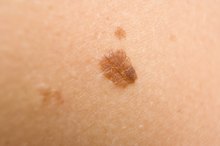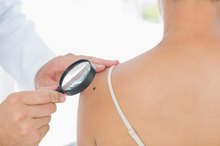A mole is a collection of pigmented cells that generally presents itself as a small, brown-hued spot on the surface of your skin. It is possible for acne to form either under -- or on top of – moles, since moles are generally just a discoloration of your skin. However, an acne-type blemish that develops under a mole may actually be a sign of an atypical, potentially dangerous type of mole.
Atypical Moles
Moles are extremely common. In fact, nearly every adult has at least one mole, according to the American Academy of Dermatology. In general, moles are completely harmless, but they can turn cancerous. Skin cancer that develops in a mole is called melanoma. Atypical moles warrant a greater degree of concern and should be immediately examined by your doctor 1. Atypical moles include moles that include acne-like features.
- Moles are extremely common.
- In general, moles are completely harmless, but they can turn cancerous.
Acne-like Symptoms of an Atypical Mole
Why Is a Mole Raising Up on Skin?
Learn More
You should be suspicious of moles that contain acne-like symptoms. For example, a mole that grows larger, becomes inflamed or bleeds is considered atypical. Furthermore, a mole that discharges pus or other fluid – similar to a pimple – warrants concern. Moles that become raised or change to a red hue are also considered atypical. If your mole becomes bothersome in any way – painful, uncomfortable, itchy, swollen – consult your doctor as quickly as possible.
- You should be suspicious of moles that contain acne-like symptoms.
- Furthermore, a mole that discharges pus or other fluid – similar to a pimple – warrants concern.
Treatment of Atypical Mole
As a general precaution, your moles should be examined by your doctor about once a year. However, if you develop a new mole or if an existing mole develops into an atypical mole, see your doctor immediately. Your doctor will most likely take a biopsy of your atypical mole 1. If the biopsy indicates that your mole is cancerous, treatment generally involves surgery to remove the melanoma. If the cancer has spread to your lymph nodes or other organs, you may require additional treatment such as chemotherapy or radiation.
- As a general precaution, your moles should be examined by your doctor about once a year.
- If the biopsy indicates that your mole is cancerous, treatment generally involves surgery to remove the melanoma.
Treatment of Acne
Age Spots and Moles
Learn More
If your mole biopsy comes back negative and your doctor determines that your mole is benign, talk to your doctor about the possibility of acne forming under your mole. If your doctor determines that you do have acne under your mole – as opposed to an irritated or infected mole – seek treatment for your acne breakouts. Typical treatments for acne include over-the-counter topical ointments, lotions and cleansers 3. Depending on the severity of your acne, your doctor may prescribe a topical or oral medication to help combat the problem.
- If your mole biopsy comes back negative and your doctor determines that your mole is benign, talk to your doctor about the possibility of acne forming under your mole.
- Depending on the severity of your acne, your doctor may prescribe a topical or oral medication to help combat the problem.
Related Articles
References
- Family Doctor: Skin Cancer – Atypical Moles
- MayoClinic.com: Melanoma -- Treatments and Drugs
- MayoClinic.com: Acne -- Treatments and Drugs
- American Cancer Society. How to Spot Skin Cancer. Updated 07/06/17. https://www.cancer.org/latest-news/how-to-spot-skin-cancer.html
- Canadian Cancer Society. Signs and Symptoms of melanoma skin cancer. http://www.cancer.ca/en/cancer-information/cancer-type/skin-melanoma/signs-and-symptoms/?region=on
- American Cancer Society. Key statistics for melanoma skin cancer. Updated August 14, 2019.
- Children's Hospital of Philadelphia. Congenital nevus (mole).
- U.S. National Library of Medicine Genetics Home Reference. Are moles determined by genetics? Updated December 2017.
- National Cancer Institute. Genetics of skin cancer (PDQ) - health professional version. Updated January 3, 2020.
- American Society of Clinical Oncology. Melanoma: symptoms and signs. Updated January 2019.
- Skin Cancer Foundation. Melanoma warning signs. Updated April 2019.
- National Cancer Institute. Melanoma risk assessment tool.
- American Cancer Society. How to Spot Skin Cancer. Updated 07/06/17.
- Canadian Cancer Society. Signs and Symptoms of melanoma skin cancer.
Writer Bio
Kathryn Gilhuly is a wellness coach based in San Diego. She helps doctors, nurses and other professionals implement lifestyle changes that focus on a healthy diet and exercise. Gilhuly holds a Master of Science in health, nutrition and exercise from North Dakota State University.









